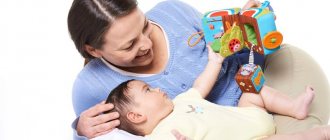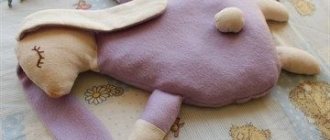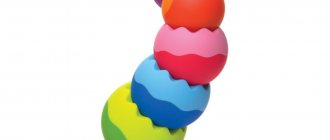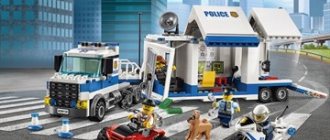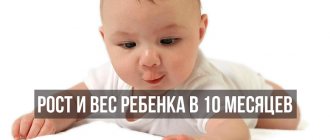A child at 9 months of age usually manifests himself as a tireless explorer of the world around him. It is during this period that the little man's curiosity reaches its apogee. In order for the child’s physical and intellectual abilities to develop in the right direction, it is important to wisely select toys for a 9-month-old child.
How to make the right choice of toys? What should you pay attention to when organizing the gameplay? What actions of parents will allow the child to gain independence? We will talk about this and more in the material presented.
Physiology of a 9-month-old baby
The main skill that children master at this age is the ability to sit down and more or less confidently stay on their feet without outside help. If this does not happen for a long time, parents should seek advice from a specialist. The cause may be neurological disorders that were acquired by the child at the stage of intrauterine development.
What toys for a 9-month-old baby deserve the attention of caring parents? First of all, these are devices and structures that will help the baby independently stand on his feet in an upright posture. It is quite difficult for a child to learn to move independently. After all, a mentally fragile person has to make remarkable efforts aimed at coordinating a large number of small movements. However, when choosing toys for a 9-month-old baby that will allow him to get on his feet, you shouldn’t force things too much. It is important to wait until the baby is ready to move independently.
Funny plates
You need: 5-6 plates (preferably multi-colored) made of wood or plastic.
This exercise should teach the child to correctly grasp objects by opposing the thumb to the index finger (the so-called tweezer grip).
You move the stack of plates closer to the child, remove the top one and hand it to him. When your baby reaches out with his hand to take the plate from your hands, make sure he does it correctly: his thumb should be on top of the plate, and the other four should be on the bottom.
If the child tries to grab the plate by the edge with his fist, carefully correct his fingers. Look at the plate with your child, discuss its shape, color, size, surface (smooth, rough), etc.
Then pass him the next plate. Having finished studying the plates, put them in a pile again, and move the pile towards the child - let him take them one at a time and scatter them around. At the end of the lesson, assemble the pile one last time, inviting the child to place 1-2 plates on top.
Skills developing in children at 9-10 months of life
At this time, children develop the following skills:
- take a sitting position;
- actively move on all fours, stand on your feet, holding on to auxiliary objects;
- take a few steps while holding the hands of your parents;
- respond to commands and requests;
- point to named objects;
- tear paper, crumple soft things, crush plasticine or clay;
- reproduce articulate sounds, imitate the voice intonation of adults.
Development of intelligence and motor skills
By 9 months, the baby’s fine motor skills begin to gradually develop. Notice how your child diligently tries to grab small objects with his fingers: pieces of bread at lunch, a flower on a walk or a pebble. Encourage your child to learn a new skill, but with caution. You should grab pieces of bread or fruit into your mouth while eating, but you should not play with coins or stones even under adult supervision. The risk of swallowing a small object is very high, even in the presence of mom and dad.
Development of fine motor skills
What does a 9 month old baby need in terms of toys? During this period, children are already aware of a lot, know the names of objects, and are able to respond to commands. Therefore, it is important for parents to select devices that will allow them to develop fine motor skills of their fingers. An excellent solution here would be toys for a 9-10 month old child, such as mosaics, simple construction sets, and all kinds of cubes. At the same time, you should not leave your child alone with such items. The baby will certainly try the toy on the tooth, which can lead to suffocation with small parts.
At 9 months of life, the child not only recognizes those around him, but is able to navigate the room and respond to the names of home furnishings. If you ask him to show where the game cubes or pyramids are, the child, if the question is structured correctly, will be able to point to the desired object.
Development of a nine month old baby
At nine months of age, the child’s ability to walk upright begins to develop. Therefore, special attention should be paid to training the musculoskeletal system, as well as developing psychological readiness for walking.
According to Dr. Komarovsky, a child at 9 months has a good short-term memory, and he remembers impressions and events well. To be fair, most of them remain in the subconscious, because consciously a person cannot remember what happened at 9 months. At the same time, there is memory, because the development of speech is impossible without the ability to remember words.
At 9 months, the baby develops the ability to move, and he needs less and less time to be held by his mother or an adult. At the same time, the baby regularly explores the world, takes various objects and studies them.
Important to remember ! Each child's development is individual. If a particular boy or girl doesn’t have some abilities, it’s okay. It won't affect his adult life.
New skills
At 9 months, a child can sit confidently without the help of an adult and sit down at his own request. If he is too lazy to move, he can reach for a toy that is located relatively far from him.
9 month old baby sitting
Without support, a child in the ninth month is able to sit for about 10 minutes. List of baby skills at this age:
- Takes the first timid steps. With a walker he can move, jump, and squat for 10 minutes.
- Crawls on all fours or on its stomach.
- Tweezer or pinch grip. Actively tries to grab small objects. Can tear paper into shreds.
- Has a strong grip.
- He clearly understands what he wants.
- Speaks simple syllables, associates words with objects. Can speak with expression.
- Knows his name.
- Has a greater range of emotions: joy, laughter, anger and even more.
- Ability to communicate using gestures.
- Understands simple requests.
- Can help a parent dress himself, and takes off his hat himself.
- Can hold a cup (with both hands) and a spoon, but mostly eats with his hands.
- Understands the location of sound.
How to organize the gameplay?
First of all, parents should pay attention to educational toys for a 9-month-old child, which will allow them to act out easy-to-understand plots. For example, with the help of teddy bears or dolls, you can teach your baby to nod, “dance” in a sitting position, and hold objects. During such a game, comments are important, as well as praise from parents. Soon the child will definitely want to repeat the manipulations that adults performed with objects.
When purchasing toys for a 9-month-old child, you should focus on choosing products that have the most bright, colorful design. This approach will allow you to attract the baby’s attention to the game process.
Doll like a person
The first thing a newborn baby perceives and reacts to is a person’s face. Obviously, no toy can replace a close adult for a baby. At the same time, from the age of 2 months onwards, it is possible and very beneficial for an infant to interact with a human “substitute”. The face does not always and does not have to be real, alive
Toys that reproduce a real face also arouse the baby's keen attention and pleasure. If possible, this person should be expressive and attractive
First of all, this is the doll's face.
For babies who do not yet know how to crawl or sit, but can only look, fairly large dolls are needed (at least 40-50 cm). with distinct linden features. It can be:
Big tumbler. This is a very important toy for a baby. She has huge, expressive eyes and a cheerful face that kids love to look at. In addition, it can be placed in a baby's crib, and his random movements will set it in motion and cause a pleasant chime.
Naked doll. With her entire appearance she resembles a baby. Looking at such a toy, the baby seems to recognize himself.
Rag or plastic dolls. They are flexible, soft, they can be given different poses, placed closer or further away from the baby’s eyes, they can dance, tumble or jump in the hands of an adult. All this pleases and occupies the baby.
Porcelain doll in clothes. Such dolls are very beautiful, their faces exactly reproduce a real face, and they are very similar to a little person. Meeting the gaze of such a doll, babies especially vividly and vigorously express their joy, which can last for quite a long time. It has been noticed that such dolls do not get boring for the baby - they can joyfully meet with a familiar toy for 2-3 months.
Kolobok is a ball with a picture. This is also a very good toy for a baby. It can be hung above the crib for your baby to watch as it rocks, or displayed on a rod for your baby to watch as it moves.
Toys depicting the appearance of an animal or bird (dog, cat, cockerel, etc.)
It is important that the “beast” has an expressive “face” with large eyes. It is especially interesting if it is a toy with a sound effect: the unexpected appearance of a sound (of course, as pleasant as possible and not too loud) will attract the baby’s attention, surprise and delight him.
As you can see, already in the first three months the child will benefit from a variety of dolls and imaginative toys. Of course, babies don’t yet play with dolls in the literal sense of the word and don’t even pick them up, but they look at them with pleasure, and such contemplation of the doll’s face brings them obvious pleasure - they concentrate, smile, perk up, hum excitedly and walk around, etc. All this certainly contributes to their social and emotional development.
It is very important that the doll, as well as any other toy, is first shown by an adult. The presence and participation of an adult makes the doll attractive, enlivens and animates it
The doll seems to “absorb” the image and attitude of the beloved adult. Subsequently, when the doll has already become meaningful and real, the baby will be happy to look at it on his own, although it is always important for him to share his impressions with mom or dad. When a child experiences intense joy or, conversely, when something upsets him, he needs the presence and complicity of a close adult. It is impossible to deny a small (as well as a large) child this natural need.
What toys does a 9 month old baby need?
When playing with your baby, you should focus on the following:
- balls made of soft materials that will contribute to the development of the child’s physical skills;
- objects that make sounds: all kinds of rubber squeakers, rattles, etc.;
- floating devices for playing in the bathroom;
- tumbler dolls of various sizes, mainly wind-up models capable of walking independently;
- toys that are realistic models of animals (plastic, rubber, soft models);
- winding, funny toys with a surprise;
- miniature copies of interior items (toy furniture, models of cutlery, samples of doll clothes);
- toys on wheels that will allow the baby to demonstrate motor activity (cars, wind-up models, carts).
Developing speech
You can teach your child to pronounce new sounds by showing him an example. The game with animals “Little Zoo” is perfect for this.
Place several animal toys in front of your little one. Show each one separately, saying: “This is a cat. She says meow. This is a chicken. The chicken says “ko-ko.” The baby will try to repeat after the adult. Therefore, articulate very clearly.
Talk to your child as much as possible about everything that surrounds him: say what the object is called, what it is needed for, what its properties are. Read children's books, recite funny poems, sing songs. All this contributes to the development of the toddler’s speech.
Activities that sharpen fine motor skills are very useful for speech development. For example:
- Drawing (with finger paints, fingers on a layer of flour, semolina, rice, buckwheat, sand);
- Working with play dough. The baby will only be able to knead it, but for now this is quite enough for the work of small muscles;
- Sorting out cereals, pasta;
- Simple finger games (“magpie-crow”, “ladushki”);
- Any actions with small objects (touching, collecting, twisting, folding).
What should you do if your child refuses to use toys offered by adults?
For the development of a child’s psyche, it is extremely important for him to imitate the activities of adults. If the toys chosen for a 9-month-old baby do not arouse interest in the toddler, parents should independently demonstrate how to have fun with such items. In cases where this approach does not produce results, it is worth consulting with a child psychologist. However, if the child does not like the toy offered by the parents too much, and its appearance does not cause anything but hysteria, it is worth putting the product aside until better times.
Playing with toys with your baby
At 10 months old, it is especially important for a child to communicate with mom and dad, as well as with other relatives and peers. Therefore, it is important to know what games can already be played using toys
- The simplest game is playing cars.
- Ball games.
- You can play on the phone with your child. Children love to imitate adults. Therefore, you can purchase a set of two phones. These can be cell phones or regular phones. You can talk to your baby while you are either in the same room or hiding behind the door. And if the phone supports the remote communication function, then even while in another room.
- You can play a musical instrument. A children's piano is ideal. Show your baby that pressing a button makes a sound. Now let the little one try to press, not necessarily the same key.
The role of books in a child’s play activity
Active interaction with books is a serious step towards the final development of a child’s speech. Viewing printed pages with parents contributes to the development of the little man’s intellect and imaginative thinking, and the expansion of his worldview. A colorful, high-quality book, filled with original, eye-catching illustrations, fulfills the need of a 9-month-old baby to receive new information about the world around him, and also gives him impressions that can last a lifetime.
Funny plates
You need: 5-6 plates (preferably multi-colored) made of wood or plastic.
This exercise should teach the child to correctly grasp objects by opposing the thumb to the index finger (the so-called tweezer grip).
You move the stack of plates closer to the child, remove the top one and hand it to him. When your baby reaches out with his hand to take the plate from your hands, make sure he does it correctly: his thumb should be on top of the plate, and the other four should be on the bottom.
If the child tries to grab the plate by the edge with his fist, carefully correct his fingers. Look at the plate with your child, discuss its shape, color, size, surface (smooth, rough), etc.
Then pass him the next plate. Having finished studying the plates, put them in a pile again, and move the pile towards the child - let him take them one at a time and scatter them around. At the end of the lesson, assemble the pile one last time, inviting the child to place 1-2 plates on top.
Development of speech understanding
During the gameplay, parents should pay attention to verbal communication. There are several tips on this matter:
- during the child’s interaction with a toy, it is necessary to name the object, describe its constituent parts, indicate what specific actions are being performed with the object at the current moment;
- Having named a toy, you need to give the child time so that he can get acquainted with the new product, hold it in his hands, examine it from different sides and wait for a verbal reaction;
- it is important that the parents’ speech in relation to the toy coincides with the moment of manipulation with the object being used;
- When interacting with a toy, one should not allow verbosity because this will not allow the baby to “catch on” to the definition that he needs to understand and remember.
Let's move more!
A nine-month-old baby does not have a lot of movement. But in addition to just movement, you can develop coordination, the vestibular apparatus, and a sense of rhythm:
- Pushers. Place the child in front of you. Take a bright ball and push it across the floor so that your baby can catch it. Ask him to push the ball to you. Of course, the first time he will not be able to deliver a jewelry-accurate transmission, but over time he will learn everything. Help him at first by catching the ball.
- Obstacles. When walking, try to walk where your baby will have more opportunities to overcome obstacles: step over bumps, pebbles, climb steps, stumps, curbs. At the same time, always praise how clever your little one is!
- Toffees. Sit opposite the child, put a bright scarf (shawl, belt) in his hands and pull a little so that the baby responds in kind. Have a tug-of-war competition. Make sure the little “toffee” wins. That's how strong it is!
- Toptygin. Place the child on his back so that his legs bent at the knees can rest against the back of the sofa. Turn on cheerful, rhythmic music, take the baby by the legs and start tapping them to the beat on the back of the sofa. Gradually weaken your efforts so that the baby begins to stomp on his own.
Activities with toys for a 9 month old baby
There are a number of games that will help your child understand the essence of the objects used:
- "Caps." It is necessary to use several caps or cups of different colors. It is necessary to build a pyramid from such devices so that the child can see it, literally in front of the baby’s eyes. You can also disassemble the structure together with your own child. Over time, the child will learn to perform such manipulations independently.
- "Thimbles." The same caps or cups are suitable for organizing such a game. Having seated the child in front of a set of such objects, it is necessary to alternately hide a small toy under them, and then pull it back out. Next, you should invite the child to remember where the object was placed and find it.
- "Box with a surprise." The technique will allow the child to show interest in new toys. Here you will need a capacious container with a lid. It is necessary to place several toys here in advance, pulling them out sequentially and showing them to the baby. In this case, it is worth naming each object and drawing the child’s attention to its details. Over time, the baby will begin to put his favorite toys into the box on his own.
- “Plates” - you need to use several multi-colored plates made of wood or plastic. It is necessary to invite the child to grab each of them by the edge. You need to make sure that your baby grasps the object correctly, placing his thumb on top and the rest on the bottom. This activity will help your child confidently hold objects in his hands.
The most suitable toys for a 9 month old baby
So, which is better to choose:
- It is very important for young boys and girls to be involved in role-playing games with their parents. Toy animals and dolls are useful for this. You should comment on all actions performed. Feed, ride in the car, put to bed, change clothes, go to visit, say hello (goodbye), ask and tell how you are doing, bathe, play ball. Over time, the baby will learn to do it himself, you just need to wait a little.
- Toys with the same functions, but different colors, textures, sizes and materials. When playing with a child, you should tell him that the car is big and green, but the little one is red. Here is a tiny smooth ball, but here is a huge one with pimples. This cube is hard and heavy, but this one is light and soft. This is a very important moment in the development of a child.
- It would be nice for the baby to have “sleep friends.” Several safe, soft toys for your child to sleep with.
- It's time to introduce your baby to toys on wheels with a stick that you push in front of you. They will help him improve his walking. Children really enjoy leaning on these toys. You can also offer your child a stomping machine, it will help him learn to stomp faster.
- A sufficient number of containers of different shapes and sizes: containers, bowls and drawers. The baby will immediately find a use for them, he will endlessly put small objects there, place containers on top of each other, etc. etc. But all this must necessarily be made of safe, unbreakable material.
- A box with a large winding key that the child can activate independently.
- Musical toys with various songs, melodies, rhymes and imitation of animal voices.
- All kinds of pyramids of various shapes and sizes. At this age, the child begins to learn to collect them without outside help.
- Sorters. This is a very diverse educational toy. They come in the form of a cube, a car, a house, a train, etc. By playing with it, the baby develops fine motor skills and learns to compare shapes by color and shape. But the sorter is not just a toy for a one-year-old child, so for now he cannot do without the help of adults.
- Children's voiced phones.
- Musical books with buttons (letters, numbers, shapes) with songs and melodies.
- Bright and colorful paper books with pictures. It is worth reading fairy tales and poems to your child, showing and telling everything that is shown in the pictures.
- In the warm season, you should definitely go with your baby to play in the sandbox. Taking with you a rake, spatula, bucket, molds, dump machine, etc.
- Finger paint. You can give your child a large sheet of paper and a jar of paint. The main thing is to make sure that he does not put paint-stained fingers in his mouth.
- Child-friendly pencils.
- Bathing toys will add excitement to water procedures. In addition to the usual rubber toys, you can give your baby a watering can and cups so that he can pour water from one container to another.
- Large puzzles of three or four elements, with a simple and clear picture.
- Sets of cubes of different sizes, colors, and materials.
- Matryoshka toys.
- Mosaics, construction sets, Legos for children with large parts.
- Dolls. Relevant for both girls and boys and will allow you to study body parts with your child.
- Balls of different sizes.
- Regardless of gender, at this age kids love doll strollers.
Does your child not play with toys?
If the child does not yet show interest in toys, you need to show by example that it is very fun and entertaining. They must be appropriate for the baby's age. Then classes with such objects will be as useful and safe as possible.
You should definitely praise your child for all his successes, and not scold him for his failures . This will boost his self-confidence and encourage him to strive for more.
Girl builds with cubes
Educational pyramid
Useful tips
At 9-10 months of age, children already begin to show their first independence. During this period, children need less care from adults than before. For this reason, when organizing gameplay, it is worth encouraging your child to be independent. For example, you should step away from your baby for a while while he interacts with toys. While bathing in the bath, you can show your child how to use a towel or washcloth. This is extremely useful for developing independence.
Physical development
In order for a child to be well developed from a physical point of view, he should be massaged daily and do light exercises . In addition, the following procedures are very useful:
- Swimming has a positive effect not only on physical but also mental development. A child can be taught to swim at any age, even if this technique has not been used before. Classes must be properly organized and conducted regularly. Only in this way can the necessary results be achieved.
- Development of certain parts of the body. To do this you need to prepare various items. A small bottle and a large spoon will do just fine. You need to serve them to the child, changing the position from horizontal to vertical and vice versa. To grasp, the baby will begin to change the position of the arms, developing hands and motor skills.
- Crawling is essential for normal physical development. The child can reach any objects himself, touch, smell and taste them. Parents must give their child freedom, taking into account safety measures.
- Walks. Experts recommend taking your baby for walks often. In addition, there is no need to force him to spend all his time in a stroller. If he is trying to take his first steps, practicing outside will only be beneficial. You should be allowed to smell flowers, touch leaves and grass, and tinker in the sandbox. This will teach the child to be independent and also develop curiosity.
- Special mats are perfect for leg training, on which the baby can crawl and walk. Often such products consist of various parts - soft, rustling, rough and prickly. It is very interesting for children to practice on such a rug. Of course, you can make it yourself from different fabrics.
